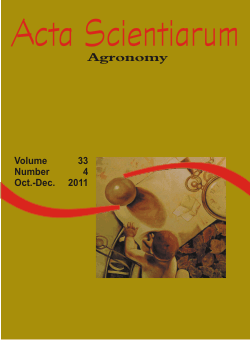<b>Prediction of soil chemical attributes using optical remote sensing</b> - doi: 10.4025/actasciagron.v33i4.7975
Resumo
Soil fertility variability management is one of the pioneering and important areas in which Precision Agriculture has been commercially applied. Consequently, the objective of this work was to predict soil chemical attributes through spectral responses. The 1,000 ha study area used for this report was located in Uberlândia, Minas Gerais State, Brazil. Thirty sampling points were established, at which the soil was collected at 3 different depths. The samples were chemically and physically analyzed and the radiometric data obtained in the 400 – 2500 nm range. Multiple regression equations were generated for sum of bases, cation exchange capacity, base saturation, aluminum saturation, pH, P, K, Ca, Mg, Al, and H, all using 60 soil samples. H, Al, m%, and pH were found to have R2 values less than 0.50. Equations with an R2 > 0.50 for the other attributes were tested for the 30 unknown soil samples, and the estimated values were obtained. These values were then compared with those determined by conventional analysis. The coefficients of correlation were higher than 50% for all attributes except P and V%. Results indicated that determining chemical attributes with models that are specific for the region is feasible.Downloads
DECLARAÇÃO DE ORIGINALIDADE E DIREITOS AUTORAIS
Declaro que o presente artigo é original, não tendo sido submetido à publicação em qualquer outro periódico nacional ou internacional, quer seja em parte ou em sua totalidade.
Os direitos autorais pertencem exclusivamente aos autores. Os direitos de licenciamento utilizados pelo periódico é a licença Creative Commons Attribution 4.0 (CC BY 4.0): são permitidos o compartilhamento (cópia e distribuição do material em qualqer meio ou formato) e adaptação (remix, transformação e criação de material a partir do conteúdo assim licenciado para quaisquer fins, inclusive comerciais.
Recomenda-se a leitura desse link para maiores informações sobre o tema: fornecimento de créditos e referências de forma correta, entre outros detalhes cruciais para uso adequado do material licenciado.




























